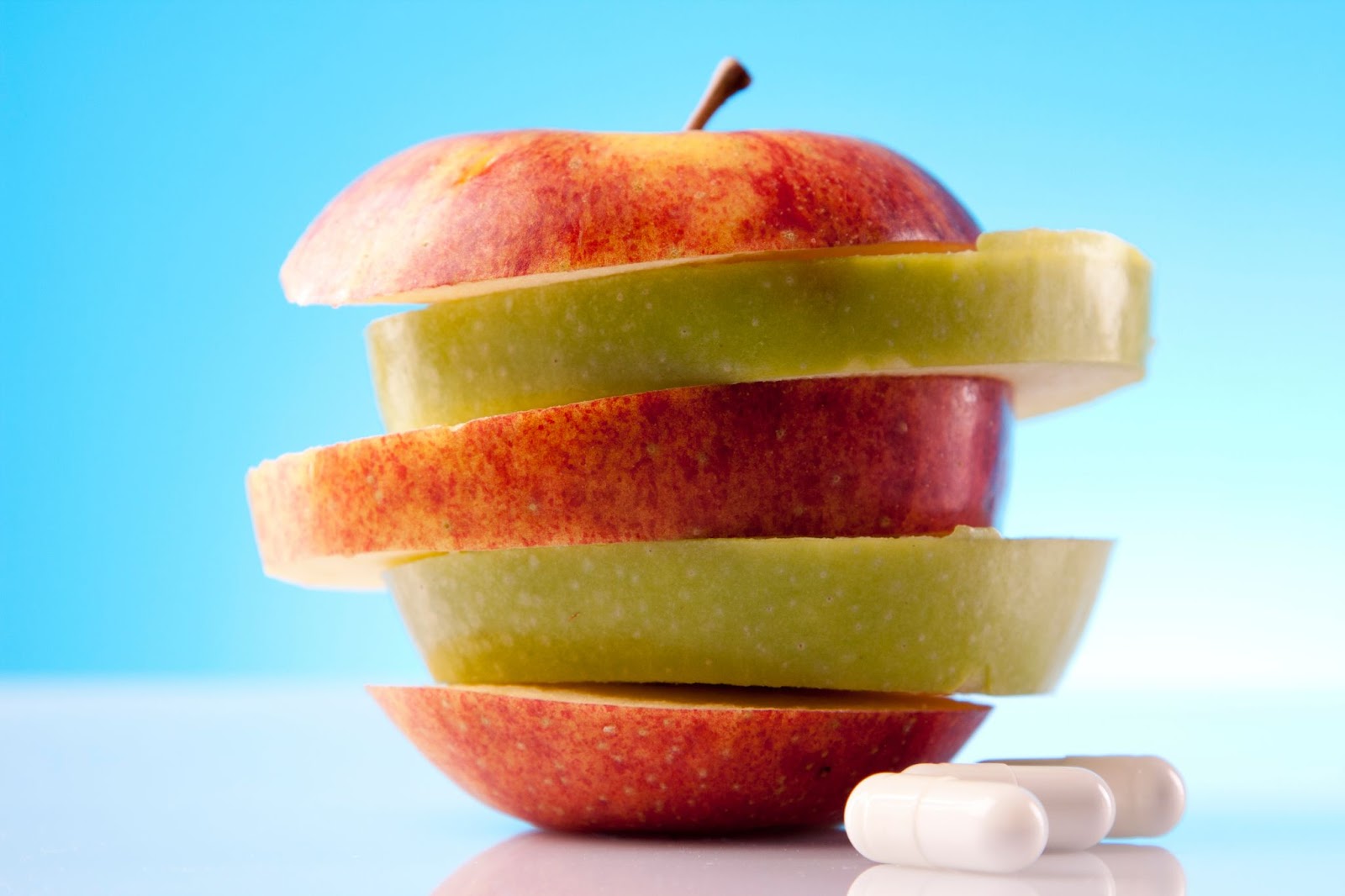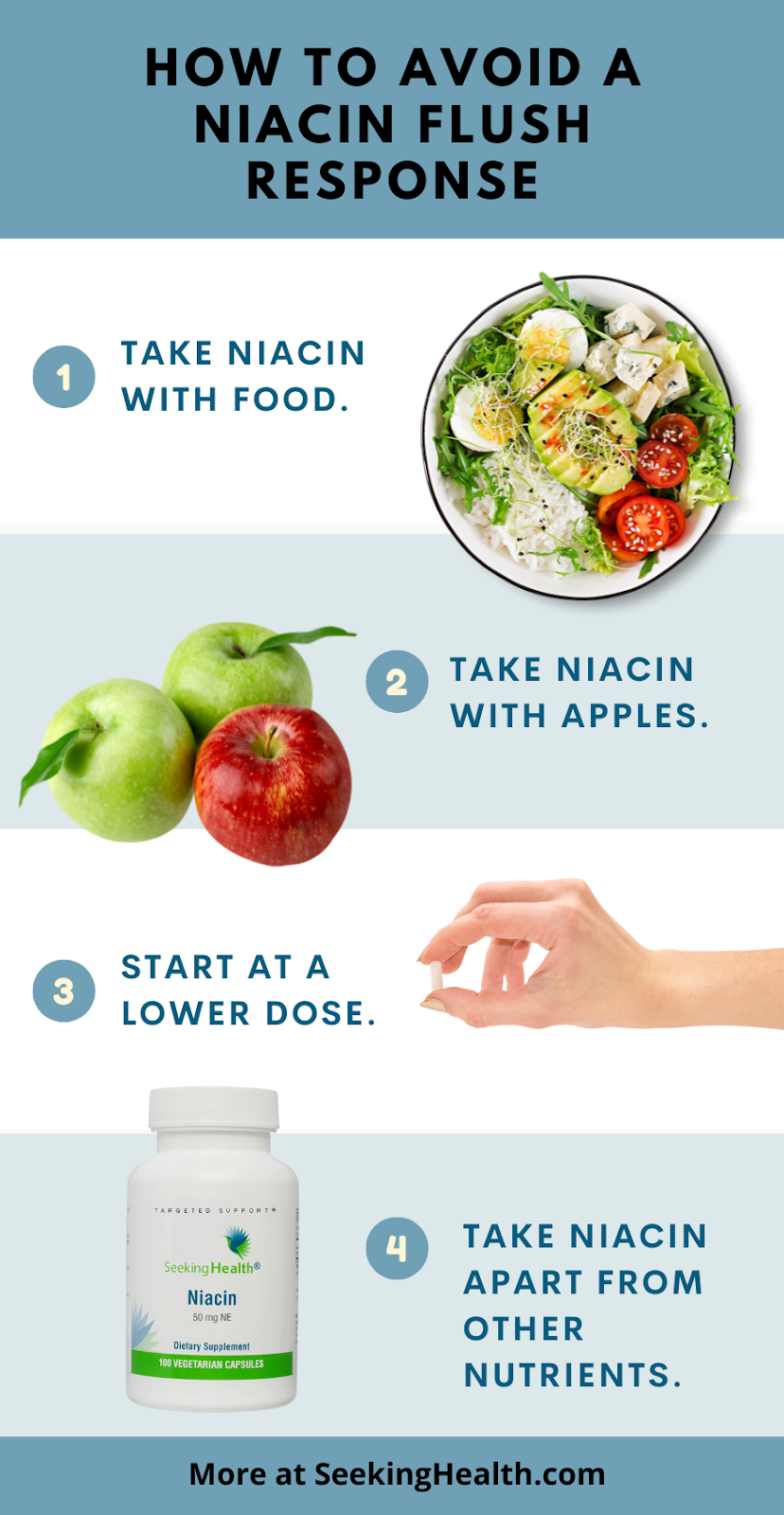Niacin Flush: Harmful or Helpful?

Have you ever taken a supplement and flushed red a little while later? It’s natural to assume you’ve had an allergic reaction. Unlike other nutrients, niacin, also known as vitamin B3, causes something known as the niacin flush. This harmless reaction can occur if you take more niacin than your body is used to taking. It can also happen if you don’t take niacin-containing supplements with food.
In this article, you’ll learn more about the niacin flush, its benefits, what to do if it happens, and how to prevent it.
What is the Niacin Flush?

Niacin (vitamin B3) is a water-soluble B vitamin. It is found in supplements like multivitamins, prenatal vitamins, B complexes, and more.
Niacin flushing is a side effect of taking higher doses of vitamin B3 supplements. It looks like red flushing on the skin. Sometimes it may also feel like itching or burning sensations. (1)
A niacin flush is not usually caused by the small amount of niacin found in most multivitamins. However, if you take additional niacin, you may be more likely to experience a niacin flush. For example, if you take niacin as a standalone supplement or in a B-complex form along with other niacin supplements, you may experience a niacin flush. Flushing is also a common side effect of taking niacin in the form of nicotinic acid.
As many as one-fifth of people who supplement with niacin end up stopping because of the flushing side effect.
However, many do not understand what causes niacin flush or that it is harmless. In fact, niacin flushing has some benefits!
Niacin causes subcutaneous vasodilation. This means that it helps dilate, or expand, the blood vessels under the surface of the skin. This triggers a reddening or flushing appearance or sensation. It is a temporary side effect. It does not damage capillaries and is not dangerous. In fact, vasodilation leads to better circulation, capillary flushing, and increased blood flow to the surface of the skin.†(1, 2)
What Does the Niacin Flush Feel Like?

In many cases, niacin flushing just looks like a reddened appearance of the skin. It generally occurs on the face or upper body. Occasionally it affects the legs. It usually looks like the type of redness you get from a sunburn. A niacin flush can happen quickly – within five minutes of taking niacin – or may not appear for 15-45 minutes. (3)
Sometimes there is a feeling of warmth, tingling, or itchiness with the flushing. This can be uncomfortable for some. If you don’t know what to expect, it can feel alarming. This is the main reason that people stop taking niacin. (4)
If you have histamine intolerance or other food sensitivities, it’s easy to confuse the reddening reaction with a histamine response or immune activation. But a niacin flush is neither of these things.
Researchers have worked to create “no-flush” niacin or extended-release versions, but that comes at a price. Niacin’s benefits for heart health and vascular health come from its ability to dilate blood vessels effectively.
Even though niacin flush is uncomfortable, it is a sign of this nutrient’s benefits!
Symptoms of niacin flushing include:
- Reddening of the face, neck, or upper body (like a sunburn)
- Feelings of warmth
- Mild itching
- Tingling
Most people adjust to niacin’s effects. Even if you flush when you first start taking it, it may not always happen when you supplement with niacin. (5)
If you notice other symptoms after high doses of niacin, you should consult a healthcare professional.
Is Niacin Flush Dangerous?
No, niacin flush is not dangerous.
It is a temporary reaction to the ingestion of niacin (nicotinic acid) from supplements.
A niacin flush is actually a sign that your body is getting the benefits of niacin!
When taken on an empty stomach, a healthy response to niacin supplementation may include mild blushing, warming, or tingling of the skin. This can appear on the ears, face, arms, torso, or occasionally on the legs.
You should always ask your doctor about dietary supplements if you take other medications, are pregnant, or breastfeeding. The use of niacin in large doses in pregnancy or with other medical conditions should be approved by your doctor.
How Long Does the Niacin Flush Last?
Niacin flush normally goes away within an hour.
It happens because niacin causes the widening of blood vessels. This process, known as vasodilation, leads to better circulation, capillary flushing, and increased blood flow to the surface of the skin.
To minimize or prevent flushing, consider taking niacin supplements with food or in divided doses.
How To Calm Niacin Flush

If you experience a niacin flush, it will go away on its own without any treatment. It typically subsides within an hour after taking a niacin supplement.
If you want to prevent niacin flush, take your niacin supplement with food. You can also start with a smaller dose and work your way up to a higher one.
People typically adjust to the flushing response of niacin as their bodies get used to taking it.
How to Avoid a Niacin Flush
There are several ways to avoid getting a niacin flush.
Take niacin with food
The niacin flush can be avoided by taking any niacin-containing supplements with food. You can take it during the day with any meal. If you are very sensitive, you can take it before bed with a small snack so that any potential flushing reaction occurs when you are asleep. However, niacin found in B-complex supplements or multivitamins should typically not be taken before bed, as B vitamins are stimulating and can make it hard to sleep. (6)
Take niacin with apples or applesauce
If you are very sensitive to and still experience some flushing that you want to avoid, take niacin with an apple or applesauce. The pectin found in apples helps decrease the appearance of flushing but does not negate the protective effect of niacin. (7)
Start at a lower dose
If you are new to niacin, start at a lower dose. This helps your body adjust to it and can minimize flushing reactions. (6)
Take niacin away from other supplements
Nutrients like niacin may interact with other minerals or vitamins. Taking niacin with zinc, for example, may make flushing symptoms more likely. Take standalone niacin supplements away from other solo nutrients to minimize this reaction. (8)

Why Do People Take Niacin?
People supplement with niacin for many reasons.
Niacin, along with other B vitamins, plays an important role in converting food and nutrients into energy for the body.† (9)
More than 400 enzymes in the body require the active form of niacin to work. This makes niacin busier than any other coenzyme that comes from vitamin sources! Without enough niacin, your body’s metabolic activity can be limited on many levels.† (10)
You also need niacin’s active form for:† (10, 11)
- Essential cellular function
- Maintaining genome integrity
- Regulating gene expression
- Cellular communication
- Maintenance of cellular antioxidant function
- Synthesizing correct amounts of cholesterol levels and fatty acids
- Proper function of the central nervous system
- Promoting healthy aging, skin, and energy
- Supporting healthy metabolism
Niacin is sometimes recommended by medical professionals for supporting a healthy lipid balance between HDL cholesterol and LDL cholesterol.† (11)
Niacin Supplements

You may not experience a niacin flush, even if you take a supplement that contains it. However, if you take more than one supplement that contains niacin, it can be more likely. Remember that niacin flush is a harmless response. It indicates that niacin is leading to blood vessel dilation, one of its benefits.†
Seeking Health’s Niacin capsules provide niacin as nicotinic acid. This pure form of niacin, unlike other forms (e.g., niacinamide or inositol hexanicotinate) has powerful benefits for cardiovascular health.†
Niacin (as nicotinic acid) supports:†
- Cardiovascular health
- Energy production
- Healthy metabolism and weight management
- Detoxification
- Digestive health
- Skin and cartilage health
- Positive mood and cognition
- NAD+ and NADPH levels
- Tryptophan and serotonin levels
- Normal cholesterol levels
- Side effects from methylated nutrients
Seeking Health supplements that contain niacin include:
- Niacin Capsules
- Histamine Block Plus
- B-Minus
- B Complex Plus
- Optimal Sleep
- Optimal Sleep II
- Methylate
- Optimal Multivitamin
- Optimal Multivitamin Plus
- Optimal Multivitamin Chewable
- Kids Multivitamin
- Multivitamin with Iron
- Optimal Prenatal
- Optimal Prenatal Methyl-Free
- Optimal Man
- Prenatal Essentials Chewable
- Prenatal Essentials
- Prenatal Essentials Methyl-Free
- Optimal Start
The Bottom Line
Experiencing a niacin flush can be alarming, especially if you are not expecting it. But it is a harmless side effect of this crucial B vitamin. Niacin flushing normally goes away within an hour after taking niacin. To minimize this effect, you can take your niacin supplements with food. You can also start at lower doses to avoid the niacin flush response.
Most people adjust to niacin’s effects. Even if you flush when you first start taking it, it may not always happen when you supplement with niacin.
While the niacin flush may be uncomfortable, it is a sign of this nutrient’s benefits! It happens because niacin causes the widening of blood vessels. This process, known as vasodilation, leads to better circulation, capillary flushing, and increased blood flow to the surface of the skin.
If you have questions about niacin health benefits, always speak to your healthcare provider for personalized advice.
References
- https://www.ncbi.nlm.nih.gov/pmc/articles/PMC2779993/
- https://pubmed.ncbi.nlm.nih.gov/17008386/
- https://www.sciencedaily.com/releases/2017/02/170206131515.htm
- https://www.ncbi.nlm.nih.gov/books/NBK114304/
- https://pubmed.ncbi.nlm.nih.gov/1855354/
- https://www.ncbi.nlm.nih.gov/pmc/articles/PMC2848425/
- https://www.ncbi.nlm.nih.gov/pubmed/23415433
- https://www.mayoclinic.org/drugs-supplements-niacin/art-20364984
- https://pubmed.ncbi.nlm.nih.gov/26828517/
- https://ods.od.nih.gov/factsheets/Niacin-HealthProfessional/
- https://www.ncbi.nlm.nih.gov/books/NBK541036/
Topics: Dietary Supplements, Health Tips, Niacin, Niacin Flush, Supplementation
